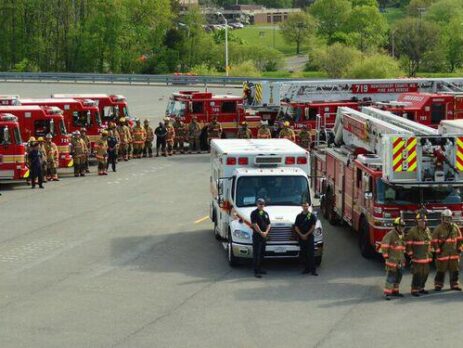Whole Blood in EMS Promises a Revolution in Resuscitation
How one county agency is saving lives with prehospital transfusions
“It has been said that the three most regulated things in medicine are nuclear medicine radioisotopes, chemotherapy drugs and blood products,” says Assistant Chief Tim Burns, Chief Training Officer at Montgomery County (Md.) Fire and Rescue Service (MCFRS). That’s because whole blood, along with its component parts, is almost always in short supply and require complex storage mechanisms and tight storage controls. But recent medical experience has established that prehospital blood transfusion is feasible and saves lives – and to a much greater degree than had been understood.
How does a public safety agency obtain and maintain the critical resource that is whole blood while getting it into the field to save lives? As Montgomery County shows, it can be done, and to great effect with some forethought and cooperation.
A Brief History of Whole Blood Transfusion
Whole-blood transfusions aren’t new. They date back to British medical experiments of the 1600s and were increasingly common by the 1800s. The efficacy of whole-blood and plasma transfusions became clear during the World War II. Those who received this care saw mortality halved.
While prehospital blood transfusions were common during the First World War, they were mostly relegated to hospitals by the Second. Challenges of blood collection, distribution, monitoring, and maintenance were complex in the field. Concerns about bloodborne illness, such as hepatitis and HIV, would further complicate matters.
That changed in 1993. During the Battle for Mogadishu in Somalia three American Black Hawk helicopters were shot down and a protracted battle took place to save the survivors. Military doctors worked in place for 48 hours straight to save who they could. This included use of whole blood transfusion on the battleground, credited with saving many of those who survived. One of those doctors, Col. John Holcomb, M.D., brought that experience back to first responders, first in Texas and now nation-wide.
The results of prehospital blood transfusion in American public safety have been remarkable. One study finds patients who received whole blood in the field saw a 48% decline in mortality for blunt and penetrating trauma.
“Blood is the most powerful intervention in the past 50 years,” says Jon Krohmer, MD, FACEP-FAEMS, steering committee chair at the Prehospital Blood Transfusion Initiative Coalition. To be effective, this coveted resource needs to get there fast and ready.
How Montgomery County Embraced Whole Blood by Learning from Others
MCFRS rolled out its whole blood program in 2024. In the first four months of the program’s trial, 24 people received blood transfusions in the field; of those, 16 survived. What they discovered almost immediately was that whole blood’s utility is more important than they had initially thought.
“We’re seeing cases where people survive acute trauma that would have until very recently been assumed fatal,” says Krohmer. “Surgeons are seeing patients they’ve never seen before because until now there was no way to save them. That person lying on the pavement is now a witness, not a victim.”

Whole blood benefits not only trauma patients, MCFRS has found utility in medical scenarios as well.
“It’s not just the hair, teeth, and eyeballs calls,” says MCFRS’s Captain Nicholas Wagner. “It’s the nursing home calls where internal bleeding is common. You don’t want to overestimate your need, but there’s a tendency to underestimate.”
Regional Partners Are Key
MCFRS had the advantage of regional partners who went before them. Maryland State Police Aviation Command, which spearheaded the state-wide blood protocol, put nearly 4 years into that effort. “We were able to learn from not just Maryland State Police, but from D.C. Fire and Howard County [Md.] Department of Fire and Rescue Services as well,” says Burns.
As a result of working with these partners, MCFRS was able to calibrate their blood supply. “D.C. Fire Department had to almost double the amount of blood they had available initially. Our neighbors in Howard County had a similar experience, so we knew this was a possibility,” says Wagner.
The type of blood used for many whole blood programs is low-titer O positive whole blood, meaning it has fewer antibodies, and Type O+, because it is most prevalent in the donor population. Approximately 38% of the US population has the blood type O positive.
“Part of our agreement,” says Wagner, “was to set up two blood drives to support the blood bank before our launch. We also reached out to the area hospitals and let them know we were using blood so that they could expect it.”
“The biggest part is a relationship with that blood bank,” says Krohmer. “It’s a totally different culture. O-positive whole blood is like gold to them. You don’t want a medic just coming in without addressing their concerns – to maintain the integrity of their supply, zero waste, robust logistics.”
“We set up a good relationship with our trauma center,” says Burns. “We set up an intermediary, which has a good relationship with the Northern Virginia Blood Bank. The local blood bank acts as an intermediary for the blood we’ll use.”
A Process for Deployment
In Montgomery County, 4 EMS supervisors maintain a supply of 6 units of whole blood under normal circumstances. Each of the 30 employees trained to function as EMS supervisors “ go through 4 hours of classroom training, followed by 4 hours of hands-on training,” says Burns. “All of our ALS providers are trained to an awareness level as well.”
“You want to make sure that your people are following the process,” says Burns. “The process is almost important than the outcome, because blood is a precious commodity. Our goal is zero wasted units of blood”
The storage equipment and temperature monitoring equipment are low-maintenance and passively monitored via cloud services and real-time alerts. “Once a day we do an accounting and then we don’t really need to think about it too much,” he says. “Our field providers understand that we have this capability and are able to request it to the scene if an EMS supervisor was not initially dispatched on their call.”
Ensuring the Integrity of Whole Blood in the Field
Part of the zero-waste strategy involves whole blood only being deployed for a maximum of two weeks in the field before it needs to be brought back to the blood bank for component recycling. “In order to do that,” says Burns, “we need to have all the documentation about how it’s been stored and its temperature range. … We only pay for blood that is used. So, if we use it in a patient or if it goes out of the temperature range, we
To prevent waste, MCFRS keeps whole blood in coolers in vehicles. Each bag is stored with a cooling insert that will keep the blood cold for 48 hours, but which is replaced every 24. And every bag has an integrated, cloud-connected thermometer on it that will alert several people if the bag approaches or is outside of temperature range and log these values
To administer blood, it is run through a warmer to body temperature. “It’s not a regular IV infusion set,” says Burns. “It’s a hand pump that gets the blood into the patient quickly.”
Using FirstWatch to Monitor the Program’s Quality
MCFRS works with FirstWatch to monitor its whole blood program. “Process managers are integral to our work here in Montgomery County,” says Wagner. “We monitor the processes and see where we can make improvement through training or system changes. When blood is deployed by one of our EMS duty officers, we get a trigger alert from FirstWatch.”
Wagner and his team use FirstWatch’s FirstPass clinical tool to then evaluate the incident. “We can monitor the clinical outcomes and how it was deployed,” says Wagner. “In FirstPass we can also see if there were any missed opportunities. Are there gastrointestinal bleeds, for example, that we might have missed? We can trace the call back to dispatch and see if maybe the EMS supervisor was on the call.”
“They get an alert in my pocket when blood is used,” says Burns. “That lets administrators know they need to replace that bag of blood. FirstPass also let’s them know when they could have used blood but didn’t. It opens our eyes to opportunities we might be missing.”
Minutes Matter
The opportunity presented by whole blood transfusion in the field is predicated on timeliness. The sooner blood is administered to the patient, the better their chances of avoiding further injury or death. “For every minute of delay, mortality increases,” says Krohmer.
Having a whole blood program gets blood to people faster. Even in the hospital or trauma center, says Wagner, there is a delay. “There needs to be a series of requests to the pharmacy or blood bank, and so forth,” he says. “It can take upwards of 30 minutes in some cases.”
And that’s if the hospital even has blood available. “There are plenty of hospitals in the U.S. that don’t have any blood product in the emergency department,” says Kromer. “Some smaller hospitals don’t have any blood components at all.”
Conclusion
Chief Burns notes that there’s a powerful movement afoot to spread whole blood to first responder agencies nationwide. “The benefits of getting blood started faster have spread like wildfire,” he says.
“You see pockets of programs around the country,” says Burns. “In Texas, where it all started, of course, but now also South Florida and the National Capital Region, where we are. The benefits are undeniable, so it’s taking off.”
For more information on how to start a prehospital transfusion program at your agency or to learn more, visit The Prehospital Blood Transfusion Initiative Coalition. Or ask around. Chances are there’s an agency near you willing to lend a hand.













